height MAZDA MODEL 3 HATCHBACK 2005 Owner's Manual (in English)
[x] Cancel search | Manufacturer: MAZDA, Model Year: 2005, Model line: MODEL 3 HATCHBACK, Model: MAZDA MODEL 3 HATCHBACK 2005Pages: 322, PDF Size: 4.7 MB
Page 18 of 322
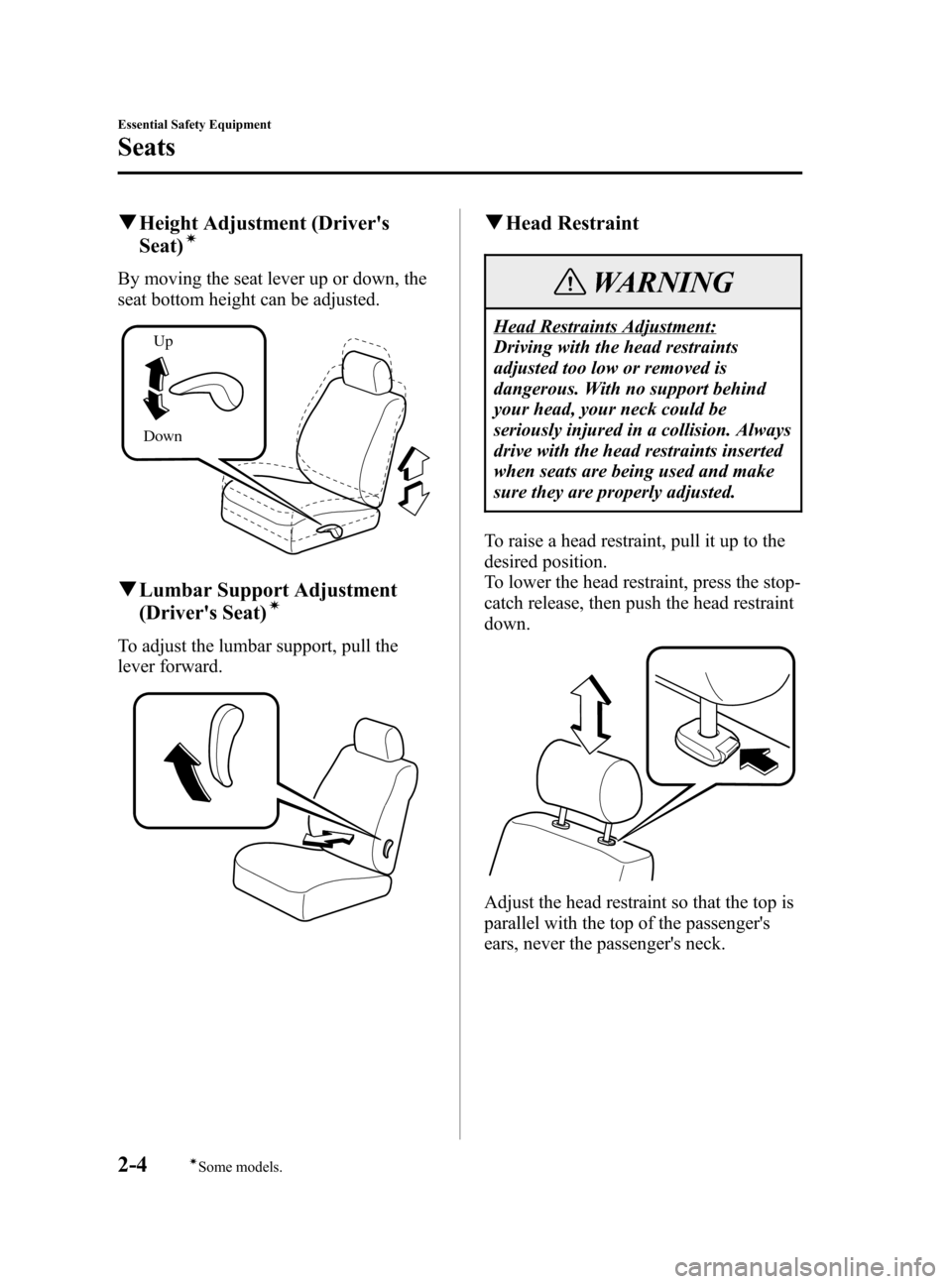
Black plate (18,1)
qHeight Adjustment (Driver's
Seat)í
By moving the seat lever up or down, the
seat bottom height can be adjusted.
DownUp
qLumbar Support Adjustment
(Driver's Seat)í
To adjust the lumbar support, pull the
lever forward.
qHead Restraint
WARNING
Head Restraints Adjustment:
Driving with the head restraints
adjusted too low or removed is
dangerous. With no support behind
your head, your neck could be
seriously injured in a collision. Always
drive with the head restraints inserted
when seats are being used and make
sure they are properly adjusted.
To raise a head restraint, pull it up to the
desired position.
To lower the head restraint, press the stop-
catch release, then push the head restraint
down.
Adjust the head restraint so that the top is
parallel with the top of the passenger's
ears, never the passenger's neck.
2-4
Essential Safety Equipment
íSome models.
Seats
Mazda3_8T97-EC-04J_Edition1 Page18
Saturday, September 25 2004 2:6 PM
Form No.8T97-EC-04J
Page 22 of 322
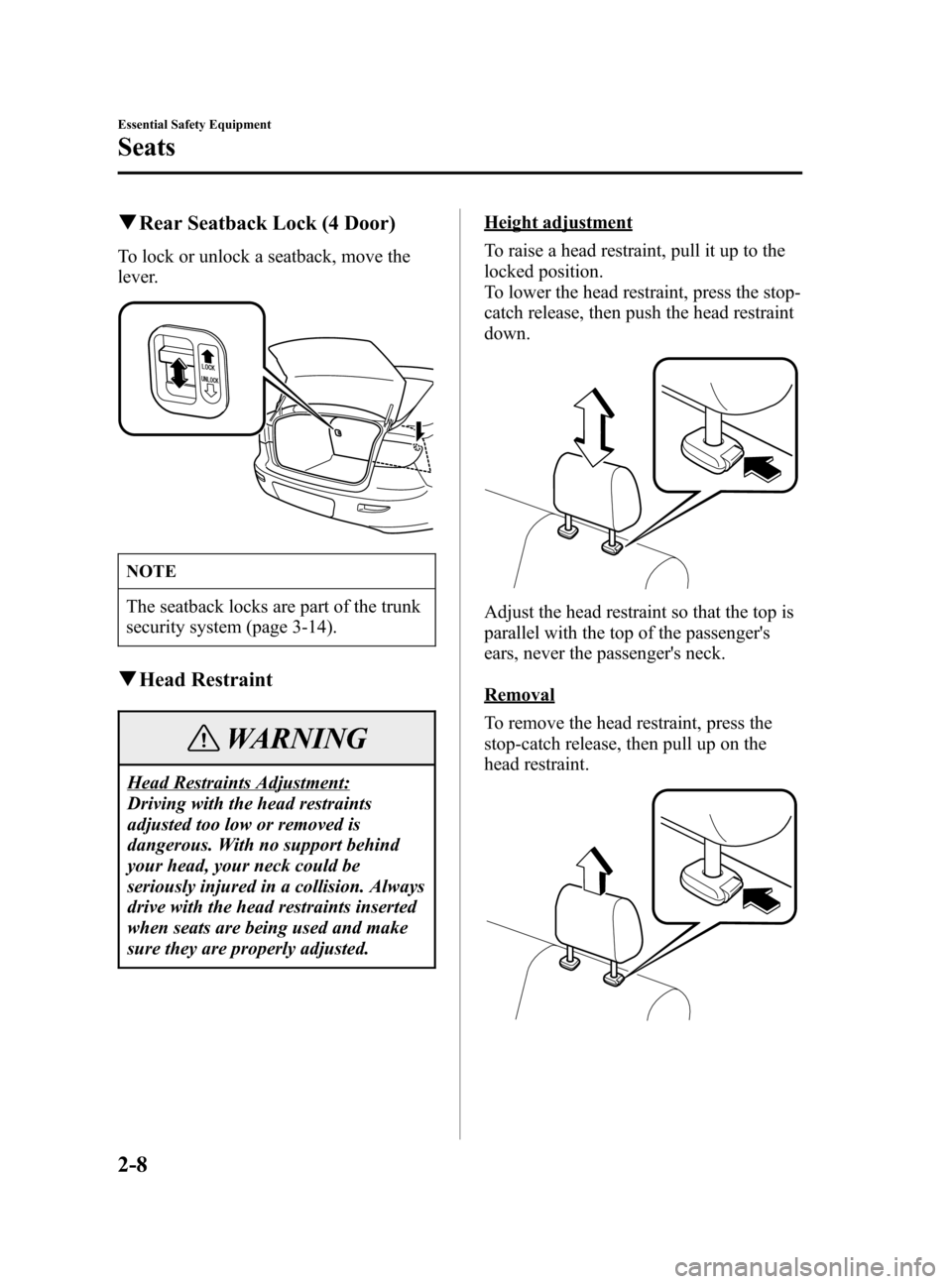
Black plate (22,1)
qRear Seatback Lock (4 Door)
To lock or unlock a seatback, move the
lever.
NOTE
The seatback locks are part of the trunk
security system (page 3-14).
qHead Restraint
WARNING
Head Restraints Adjustment:
Driving with the head restraints
adjusted too low or removed is
dangerous. With no support behind
your head, your neck could be
seriously injured in a collision. Always
drive with the head restraints inserted
when seats are being used and make
sure they are properly adjusted.
Height adjustment
To raise a head restraint, pull it up to the
locked position.
To lower the head restraint, press the stop-
catch release, then push the head restraint
down.
Adjust the head restraint so that the top is
parallel with the top of the passenger's
ears, never the passenger's neck.
Removal
To remove the head restraint, press the
stop-catch release, then pull up on the
head restraint.
2-8
Essential Safety Equipment
Seats
Mazda3_8T97-EC-04J_Edition1 Page22
Saturday, September 25 2004 2:7 PM
Form No.8T97-EC-04J
Page 27 of 322
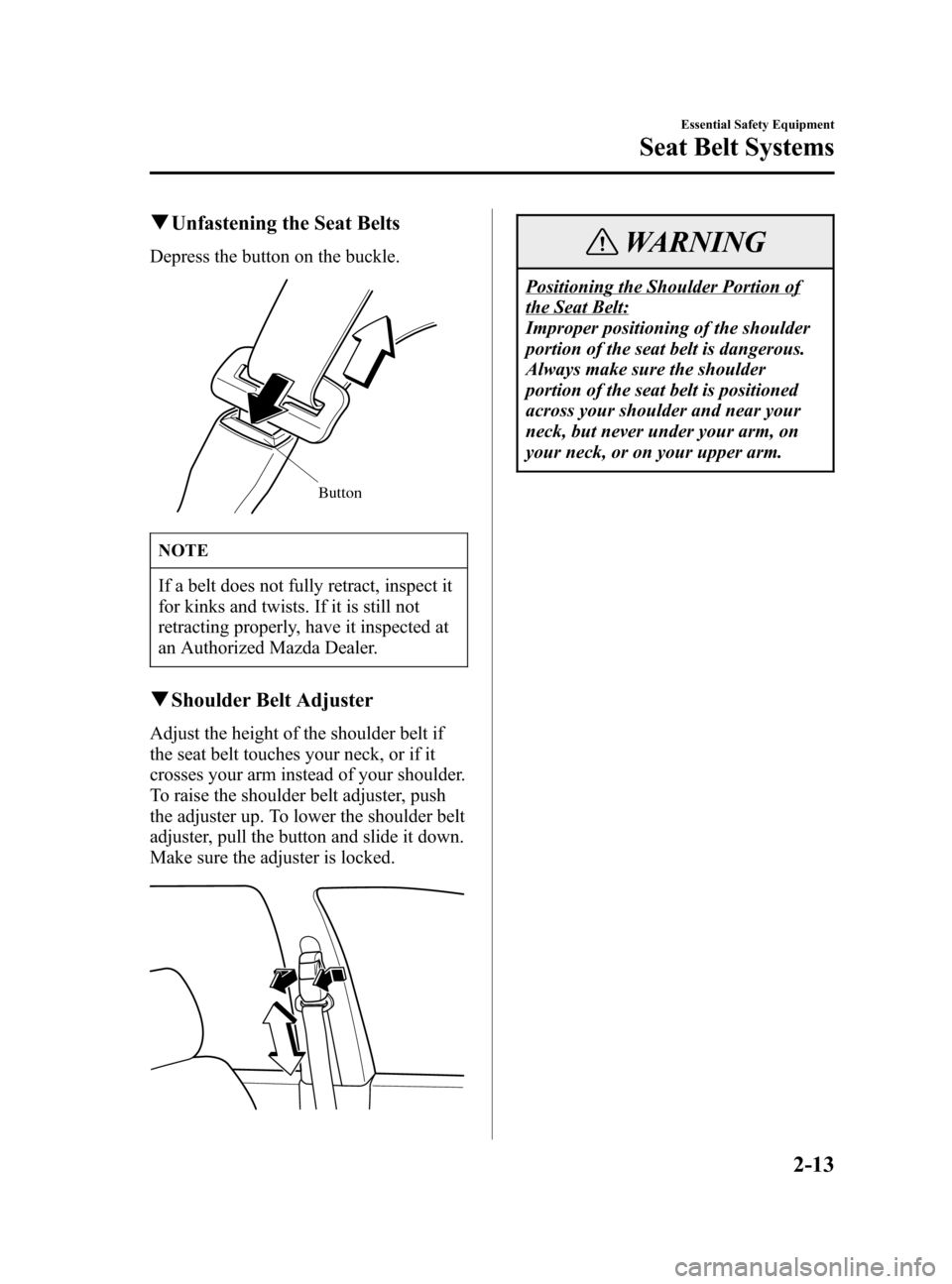
Black plate (27,1)
qUnfastening the Seat Belts
Depress the button on the buckle.
Button
NOTE
If a belt does not fully retract, inspect it
for kinks and twists. If it is still not
retracting properly, have it inspected at
an Authorized Mazda Dealer.
qShoulder Belt Adjuster
Adjust the height of the shoulder belt if
the seat belt touches your neck, or if it
crosses your arm instead of your shoulder.
To raise the shoulder belt adjuster, push
the adjuster up. To lower the shoulder belt
adjuster, pull the button and slide it down.
Make sure the adjuster is locked.
WARNING
Positioning the Shoulder Portion of
the Seat Belt:
Improper positioning of the shoulder
portion of the seat belt is dangerous.
Always make sure the shoulder
portion of the seat belt is positioned
across your shoulder and near your
neck, but never under your arm, on
your neck, or on your upper arm.
Essential Safety Equipment
Seat Belt Systems
2-13
Mazda3_8T97-EC-04J_Edition1 Page27
Saturday, September 25 2004 2:7 PM
Form No.8T97-EC-04J
Page 53 of 322
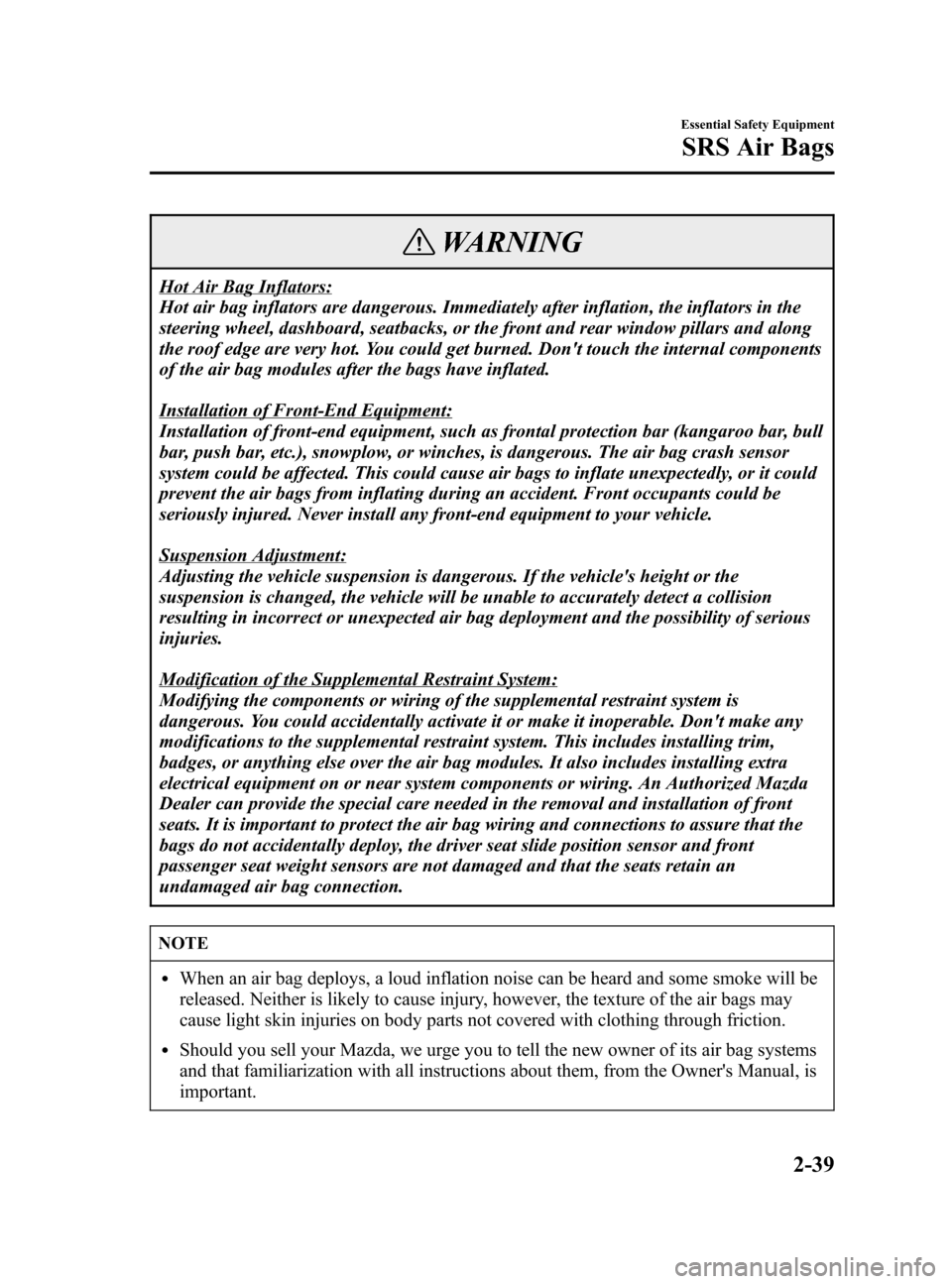
Black plate (53,1)
WARNING
Hot Air Bag Inflators:
Hot air bag inflators are dangerous. Immediately after inflation, the inflators in the
steering wheel, dashboard, seatbacks, or the front and rear window pillars and along
the roof edge are very hot. You could get burned. Don't touch the internal components
of the air bag modules after the bags have inflated.
Installation of Front-End Equipment:
Installation of front-end equipment, such as frontal protection bar (kangaroo bar, bull
bar, push bar, etc.), snowplow, or winches, is dangerous. The air bag crash sensor
system could be affected. This could cause air bags to inflate unexpectedly, or it could
prevent the air bags from inflating during an accident. Front occupants could be
seriously injured. Never install any front-end equipment to your vehicle.
Suspension Adjustment:
Adjusting the vehicle suspension is dangerous. If the vehicle's height or the
suspension is changed, the vehicle will be unable to accurately detect a collision
resulting in incorrect or unexpected air bag deployment and the possibility of serious
injuries.
Modification of the Supplemental Restraint System:
Modifying the components or wiring of the supplemental restraint system is
dangerous. You could accidentally activate it or make it inoperable. Don't make any
modifications to the supplemental restraint system. This includes installing trim,
badges, or anything else over the air bag modules. It also includes installing extra
electrical equipment on or near system components or wiring. An Authorized Mazda
Dealer can provide the special care needed in the removal and installation of front
seats. It is important to protect the air bag wiring and connections to assure that the
bags do not accidentally deploy, the driver seat slide position sensor and front
passenger seat weight sensors are not damaged and that the seats retain an
undamaged air bag connection.
NOTE
lWhen an air bag deploys, a loud inflation noise can be heard and some smoke will be
released. Neither is likely to cause injury, however, the texture of the air bags may
cause light skin injuries on body parts not covered with clothing through friction.
lShould you sell your Mazda, we urge you to tell the new owner of its air bag systems
and that familiarization with all instructions about them, from the Owner's Manual, is
important.
Essential Safety Equipment
SRS Air Bags
2-39
Mazda3_8T97-EC-04J_Edition1 Page53
Saturday, September 25 2004 2:8 PM
Form No.8T97-EC-04J
Page 263 of 322
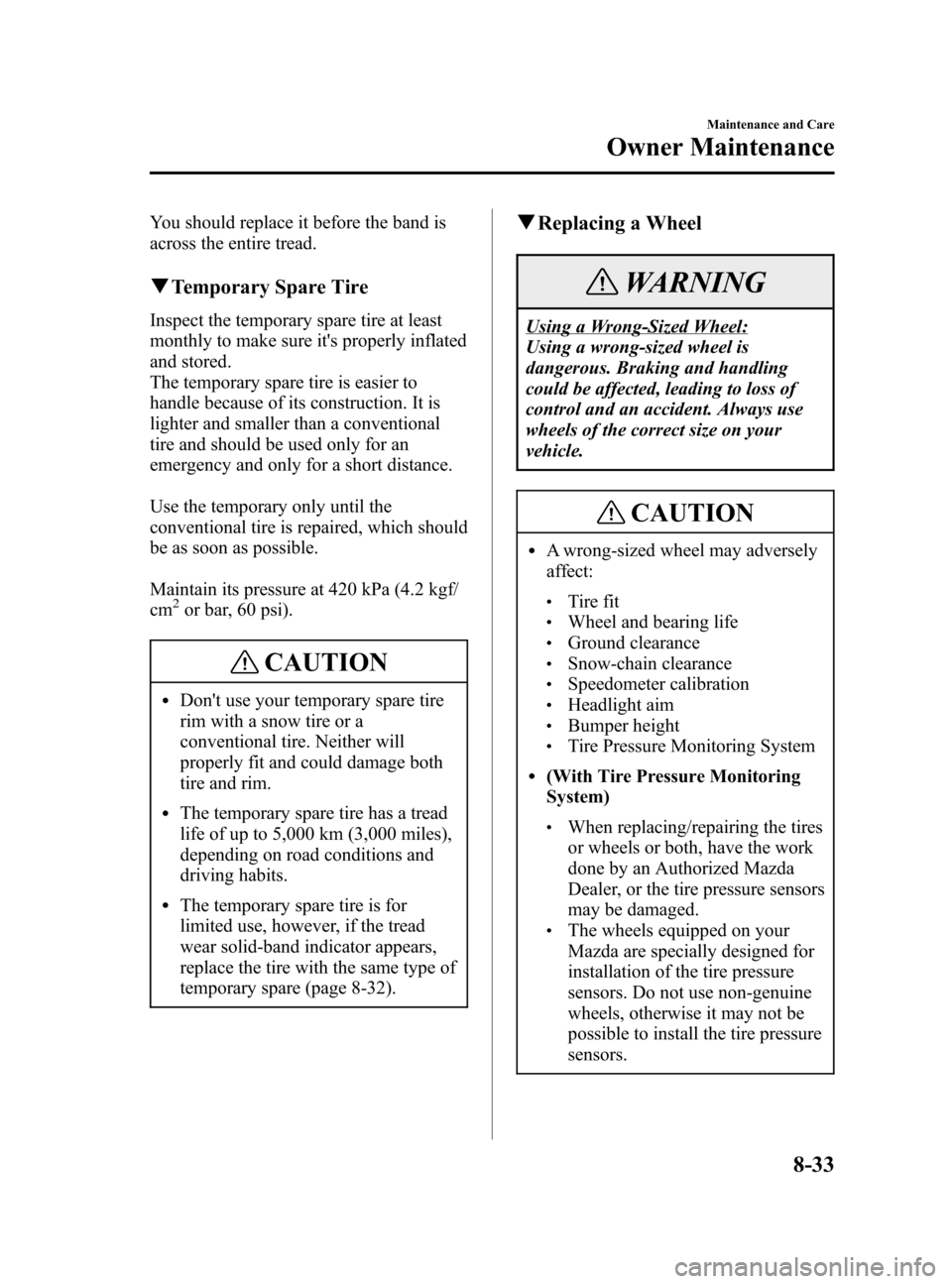
Black plate (263,1)
You should replace it before the band is
across the entire tread.
qTemporary Spare Tire
Inspect the temporary spare tire at least
monthly to make sure it's properly inflated
and stored.
The temporary spare tire is easier to
handle because of its construction. It is
lighter and smaller than a conventional
tire and should be used only for an
emergency and only for a short distance.
Use the temporary only until the
conventional tire is repaired, which should
be as soon as possible.
Maintain its pressure at 420 kPa (4.2 kgf/
cm
2or bar, 60 psi).
CAUTION
lDon't use your temporary spare tire
rim with a snow tire or a
conventional tire. Neither will
properly fit and could damage both
tire and rim.
lThe temporary spare tire has a tread
life of up to 5,000 km (3,000 miles),
depending on road conditions and
driving habits.
lThe temporary spare tire is for
limited use, however, if the tread
wear solid-band indicator appears,
replace the tire with the same type of
temporary spare (page 8-32).
qReplacing a Wheel
WARNING
Using a Wrong-Sized Wheel:
Using a wrong-sized wheel is
dangerous. Braking and handling
could be affected, leading to loss of
control and an accident. Always use
wheels of the correct size on your
vehicle.
CAUTION
lA wrong-sized wheel may adversely
affect:
lTire fitlWheel and bearing lifelGround clearancelSnow-chain clearancelSpeedometer calibrationlHeadlight aimlBumper heightlTire Pressure Monitoring System
l(With Tire Pressure Monitoring
System)
lWhen replacing/repairing the tires
or wheels or both, have the work
done by an Authorized Mazda
Dealer, or the tire pressure sensors
may be damaged.
lThe wheels equipped on your
Mazda are specially designed for
installation of the tire pressure
sensors. Do not use non-genuine
wheels, otherwise it may not be
possible to install the tire pressure
sensors.
Maintenance and Care
Owner Maintenance
8-33
Mazda3_8T97-EC-04J_Edition1 Page263
Saturday, September 25 2004 2:16 PM
Form No.8T97-EC-04J
Page 313 of 322
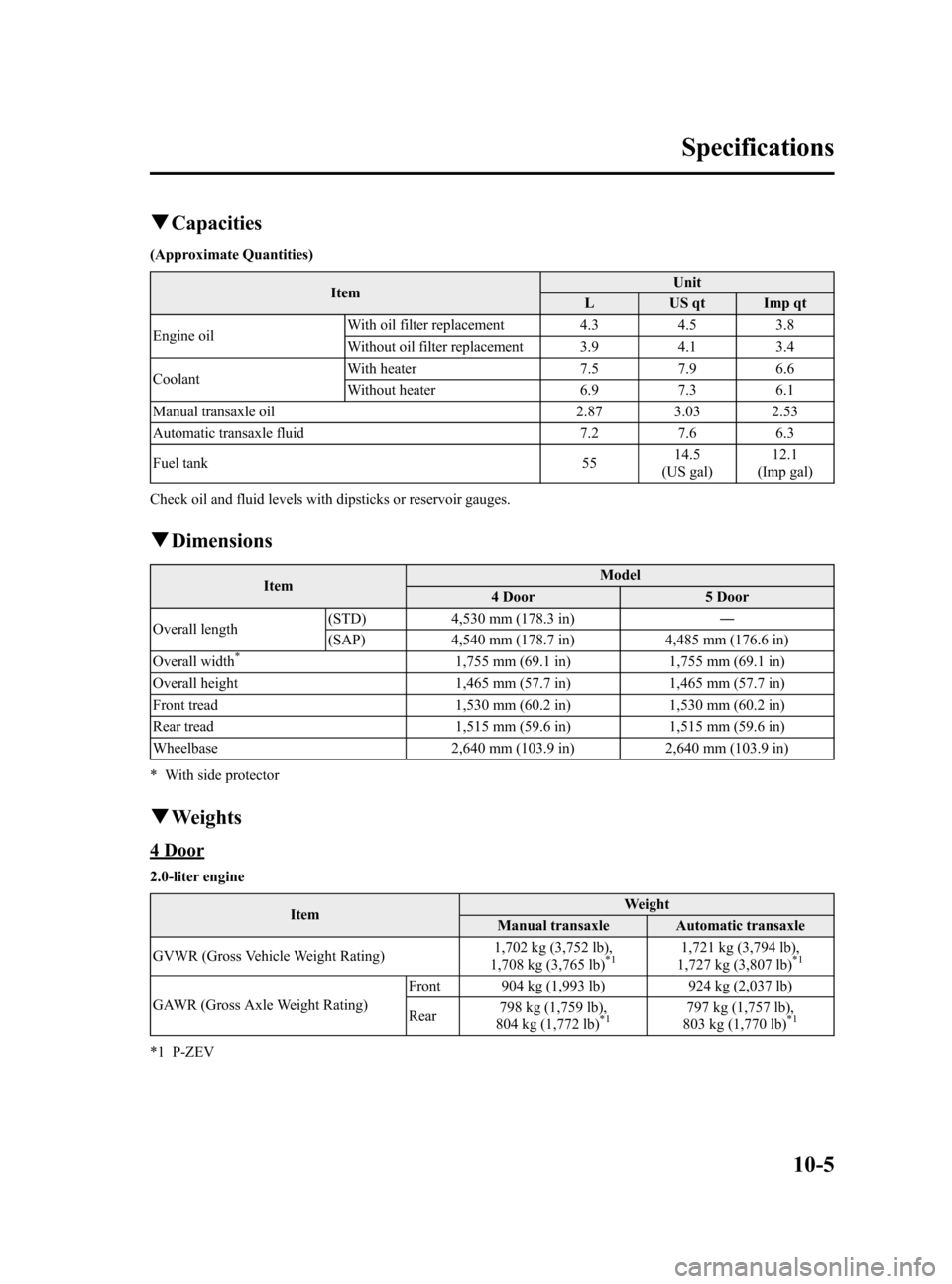
Black plate (313,1)
qCapacities
(Approximate Quantities)
ItemUnit
L US qt Imp qt
Engine oilWith oil filter replacement 4.3 4.5 3.8
Without oil filter replacement 3.9 4.1 3.4
CoolantWith heater 7.5 7.9 6.6
Without heater 6.9 7.3 6.1
Manual transaxle oil 2.87 3.03 2.53
Automatic transaxle fluid 7.2 7.6 6.3
Fuel tank 5514.5
(US gal)12.1
(Imp gal)
Check oil and fluid levels with dipsticks or reservoir gauges.
qDimensions
ItemModel
4 Door 5 Door
Overall length(STD) 4,530 mm (178.3 in)―
(SAP) 4,540 mm (178.7 in) 4,485 mm (176.6 in)
Overall width
*1,755 mm (69.1 in) 1,755 mm (69.1 in)
Overall height 1,465 mm (57.7 in) 1,465 mm (57.7 in)
Front tread 1,530 mm (60.2 in) 1,530 mm (60.2 in)
Rear tread 1,515 mm (59.6 in) 1,515 mm (59.6 in)
Wheelbase 2,640 mm (103.9 in) 2,640 mm (103.9 in)
* With side protector
qWeights
4 Door
2.0-liter engine
ItemWeight
Manual transaxle Automatic transaxle
GVWR (Gross Vehicle Weight Rating)1,702 kg (3,752 lb),
1,708 kg (3,765 lb)
*11,721 kg (3,794 lb),
1,727 kg (3,807 lb)*1
GAWR (Gross Axle Weight Rating)Front 904 kg (1,993 lb) 924 kg (2,037 lb)
Rear798 kg (1,759 lb),
804 kg (1,772 lb)*1797 kg (1,757 lb),
803 kg (1,770 lb)*1
*1 P-ZEV
Specifications
10-5
Mazda3_8T97-EC-04J_Edition1 Page313
Saturday, September 25 2004 2:17 PM
Form No.8T97-EC-04J